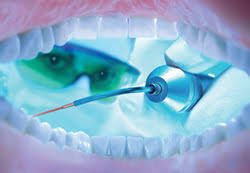A surgery workhorse gets smaller.
Dr. Frank Kubacki, Limo GmbH
For about 10 years, diode lasers have been established medical devices. They are powerful tools for surgery and for dental applications such as endodontics and paradontics because they work quickly, safely, painlessly and without bleeding.
The excellent medical results come from the coagulation and the penetration depth of the laser radiation that can be controlled by a well-defined exposure time, pulse rate and wavelength. The diode wavelengths of 808 and 980 nm are suitable because they are absorbed well in hemoglobin and melanin. Therefore, the physician achieves a high cutting speed. In addition, the coagulation avoids bleeding, which keeps the surgical area more visible.
Medical requirements for oral surgery, such as preservation of sterility, reduction of bleeding and avoidance of scarring are fulfilled by applying a diode laser that can be operated in continuous-wave or pulsed mode. The laser beam is delivered by flexible optical 100-, 200-, 400- and 600-μm fibers to reach narrow places. Micro-optics beam-shaping technology enables highly efficient fiber coupling, a compact footprint of the device and an integration of all safety accessories on board. Limo GmbH makes a diode laser that measures only 85 × 54 × 35 mm, which works well in dental offices because it does not take up much space and is relatively quiet because of water-free cooling. There is no need for space-consuming water chillers with noisy pumps.

This fiber-coupled Ora-laser from Oralia Dentalprodukte GmbH of Konstanz-Dettingen is shown here being used for children’s dentistry.
An integrated pilot laser, monitor diodes, temperature sensors and fiber sensors are important when using a laser in a medical setting. The pilot laser makes the infrared radiation of the laser visible, the monitor diodes check the laser power, and the fiber sensors disable laser radiation if no fiber is installed at the medical device. There are two sensors available for redundancy, and a standard 14-pin connector from Lemo UK Ltd. serves as the interface to the electronics.
Latest trends
The Limo forced-air cooled laser is an example of one of the latest diode modules designed for medical devices. It does not need thermoelectric or water cooling, which makes it more compact and economical. The output power of the two fiber-coupled models (measured at the output of a 200- and 400-μm fiber) are 25 and 32 W, respectively. The diode lasers operate with a maximum “pulse duration” of 10 minutes. They are available in 915-, 940- and 980-nm wavelengths and are built in an electrically isolated housing to avoid any interference from the electrical power used for the device’s other electronics. There is no electrical connection between the laser and the housing, for safety reasons. No additional electrical isolation has to be done by the medical device system integrator.
In addition, an ultrahigh-brightness source with 100-μm fibers recently was introduced that has a beam quality comparable to that of CO2 lasers. The exceptionally low beam-parameter product of 5-mm mrad yields power densities of 5 MW/cm2 in a 25-μm spot. The device is suitable for cutting applications using an exact positioning of the laser beam and high power densities.
Diode lasers are popular instruments in dental practices because of their easy handling and small footprint. The surgery is patient-friendly with low pain levels, fast healing and minimal scarring.
Meet the author
Frank Kubacki is manager of strategic marketing, product line management of lasers at Limo GmbH in Dortmund, Germany; e-mail: [email protected].